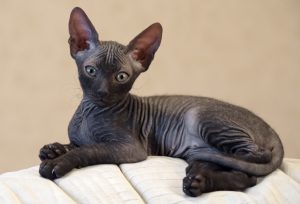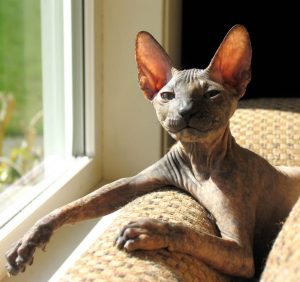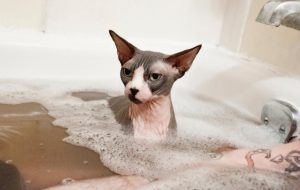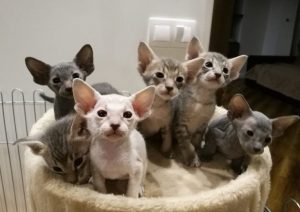The Petersburg Sphynx is a rare and unusual breed of hairless cats. Like most sphynx species, these cats are very friendly and peaceful. They are strongly attached to the owner and do not tolerate loneliness. Today, Peterbald cats are becoming more and more popular, because they do not cause allergies, do not leave scraps of fur everywhere, and get along well with children and other pets.

The Petersburg Sphynx or Peterbald is a relatively young cat breed that was bred in Russia in the early 90s. The main task of the breeders was to create an oriental cat, combining the beauty and grace of the Siamese and the non-standard appearance of the Don Sphynxes. Elite representatives of these breeds were used for crossing, as a result of which the first charming Peterbald babies appeared.
Further, the breeders needed to root the features of the breed and make them more pronounced, for which they were crossed with various breeds of oriental cats. Officially, the Petersburg Sphynx breed was recognized by the American TICA Association only in the late 90s of the last century, when it was finally formed, and the “naked” gene of the Don Sphynxes was fixed to it. Subsequent mating between the Petersburg and Don Sphinxes was prohibited. In 2003 the Peterbald breed was recognized by the World Cat Federation WCF.
It is not for nothing that the Peterbald Sphynx is considered one of the most glamorous cat breeds because its representatives are distinguished by grace, grace, and aristocracy.
Standard and main characteristics of the breed:
- The body is well built, with developed and flexible muscles. The ribcage and thighs of the St.
- Petersburg Sphynx does not differ in width, the ribs are rounded.
- The average weight of adults is from 3 to 4.5 kg. The breed has long and graceful legs with
- thick and slightly elongated pads.
- The tail of the sphinxes outwardly resembles a long thin whip.
- The shape of the head is wedge-shaped and neat, with large, erect ears.
- The neck of these cats is long and slender, in proportion to the body. A distinctive feature of
- the Peterbalds is a pronounced chin and large slanting eyes. Most often, the iris is colored blue or deep green.
- The mustache is long and curled.
Most often, Peterbalds have no hair on their bodies. The skin is mobile and gathers in folds on the body and head. The skin of the cat is soft and delicate to the touch. In kittens up to 2-3 months, a small fluff may be present on the body. After 1.5 years, cats become completely bald.

According to the breed standard, Peterbalds have 9 types of wool:
- bald-born – such kittens are initially born with smooth skin;
- hairless cat – hair completely disappears by 1.5-2 years;
- flock – very short, sparse, and soft hair is present on the body. The maximum permissible hair
- length is 2 mm;
- velours – the wool is denser than the previous type;
- brush – both soft and hard hairs can be present on the cat’s body at the same time;
- brush point – the coat is present only in certain areas, most often on the paws, tail, and head;
- straight-haired – the presence of straight short hair on the body;
- dust – such sphinxes do not have hair, and the skin is so soft and thin that it feels like dust to
- the touch;
- rubber – the skin of this type of sphinx stretches like rubber, it is very pleasant and soft in structure.
As for the color, the color of the skin of the representatives of this breed can be very diverse.
Petersburg Sphynxes are cats with a soft and peaceful character. They are sociable, moderately curious, playful, and attached to their master. Peterbalds are not afraid of strangers and always try to make friends with them when guests arrive. A distinctive feature of such cats is that they love to “talk” and often respond with meows to the owner’s remarks. These cats have a fairly loud timbre. If the owner forgets to give the pet food or the cat just gets bored, he will certainly remind of himself with a loud meow. Peterbalds loves to spend time with the owner, basking in his arms or just watching what is happening. Thanks to this attachment to humans, pets of this breed are called a cat with a canine character for a reason. If you start stroking the Peterbald, he will certainly respond with a grateful purr.

Petersburg Sphynx loves all family members but chooses for itself one owner, whom it considers a leader. After him, he will go anywhere and will defend until the very end. Since these cats do not like being alone, they are always in the spotlight. This behavior is also since it is important for Petersbolds to feel their need and importance. Even though the breed has Siamese roots, aggression and anger are not peculiar to Peterbalds. That is why pets of this breed are perfect for families with children. Petersburg Sphynx will happily play with the child or simply sit next to him, watching the actions of the child. Despite the lack of aggression, breeders advise purchasing these cats for older children. This is because after playing, the cat can unknowingly release its claws or bite. With other animals living in the apartment, Petersburg Sphynx will also easily find a common language.
Another undoubted advantage of the Peterbald people is a sharp mind and quick wit. These cats quickly become accustomed to the litter box and scratching post. Some breeders even manage to teach them tricks. Since Peterbalds are distinguished by their cleanliness, they can easily be taught hygienic procedures. They calmly and without screaming endure washing, waiting for the end of the procedure.

Due to the lack of fur, all sphynxes get dirty and sweat pretty quickly. Sebaceous glands are present on their torso, which secrete a brownish coating, the intensity of which differs depending on the pet’s health and conditions. Deciding how to maintain your pet’s hygiene depends on the situation.
The cat’s body can either be periodically wiped with special wet wipes or bathed in warm water. At the same time, breeders advise to accustom the kitten to bathing from childhood, otherwise, the cat may resist the procedure. Regardless of the air temperature, after bathing, you must wrap your pet in a towel and make sure that it does not freeze.
The optimum temperature for the Petersburg sphynxes is 23-25 degrees. If the apartment is cold, it is recommended that your pet buy a special suit, which can be purchased at the pet store. Otherwise, there is a possibility that the animal will get sick (especially in winter).
Also, caring for a Peterbald involves observing the following rules:
- the owner needs to wipe the eyes of the animal daily with a dry cotton pad so that dirt does not accumulate in them;
- it is recommended to clean the ears every two weeks and
teeth; - also, the pet needs to periodically cut its claws.
As for the choice of food, Petersburg Sphynx can be fed with both industrial feed and natural food. It is best to immediately ask the breeder what the kitten has been fed with since childhood, and what products he likes best. Most breeders prefer to feed kittens with dairy products – yogurt, kefir, sour cream. As the cat grows up, lean meat (beef, rabbit, chicken), pureed vegetables, vitamins, and trace elements useful for the pet should be introduced into the diet. The veterinarian will help you to compose the optimal diet for Peterbald.
If the choice fell on industrial food, it is recommended to feed the pet only with premium or super-premium food, which is distinguished by a balanced and natural composition. The brown grease that stands out on the body will help to determine how correctly the diet is selected and whether it is suitable for the pet. If there is too much of it, then the diet needs to be adjusted. Due to the lack of wool, the St. Petersburg Sphynx has an increased metabolism, which leads to a good appetite. The best option is to give the animal food 3-5 times a day but in small portions. With this approach, the animal will not feel hungry, and the gastrointestinal tract will work properly.
Since Peterbalds have increased heat exchange, their body always remains hot. Fever is a feature of the breed, not a symptom of the disease.
Peterbalds are a young breed that does not have hereditary diseases. Such cats are distinguished by strong immunity and health. With timely vaccination, quality feeding, and good care, pet health problems will not arise. The average life expectancy of the St. Petersburg Sphinx is 14-16 years.

But breeders of the breed should take into account that due to the lack of fur, such cats are more susceptible to colds, especially in the winter season. To minimize the risk of illness, the owner needs to maintain a certain temperature in the room or dress the pet. The second ailment that representatives of the breed may encounter is an allergic rash, which can make itself felt at regular intervals. You can get rid of these breakouts by using a regular acne lotion. But it is best to select a remedy with a veterinarian.
Breeders advise taking kittens from their mother no earlier than 3 months. If you do this earlier, it will be difficult for the kitten to experience separation from its mother, which will negatively affect its health.
Since the Peterbald is a rare breed, viscous difficulties are inevitable. If the owner plans to breed the breed in the future, it is recommended to keep in touch with the breeder, who will help to find a good partner. Before mating, the cat must be etched from worms and make sure that there are no other diseases.
Peterbald is a wonderful breed of cats that will suit a responsible owner. These exquisite pets require constant care, so they cannot be left unattended. In response to care and attention, they will respond with affection and endless adoration.

